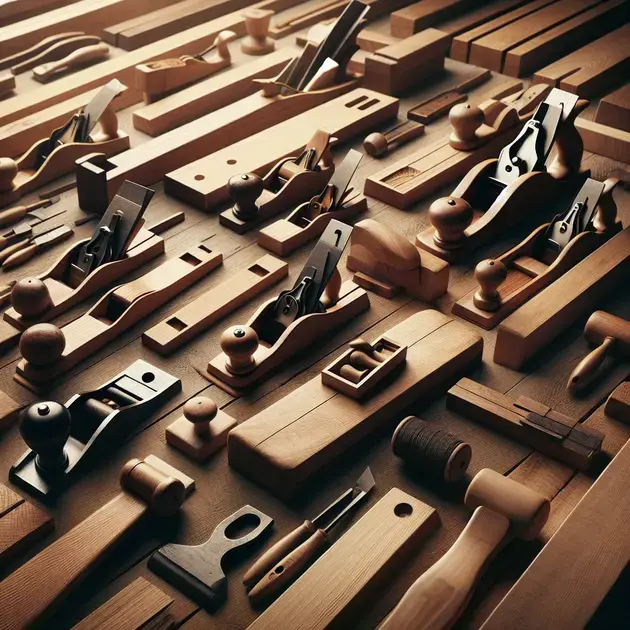Are you ready to embark on a woodworking journey and master woodworking planes? This beginner’s guide is here to help you navigate through the intricate world of woodworking planes, teaching you everything you need to know to get started on the right foot. Whether you’re looking to create smooth finishes, tackle intricate joinery, or shape wooden surfaces with precision, mastering woodworking planes is an essential skill for any woodworking enthusiast.
With the resurgence of handcrafted and artisanal woodworking, mastering woodworking planes has become a valuable skill sought after by many woodworkers. Understanding the different types of planes, how to properly set them up, and techniques for using them effectively can elevate your woodworking projects to the next level. In this guide, we will explore the fundamentals of mastering woodworking planes, providing you with the knowledge and confidence to enhance your woodworking skills and create beautiful, professional results.

Unlock the Secrets of Woodworking Planes
Woodworking planes are essential tools for creating smooth finishes on your woodworking projects. To unlock the secrets of using woodworking planes effectively, it’s crucial to understand the different types of planes available and how to properly maintain and sharpen them. One valuable resource for beginners looking to learn more about woodworking planes is the Fine Woodworking website. This site offers in-depth articles, tutorials, and videos on using hand planes for various woodworking tasks.
To start mastering the techniques for smooth finishes with woodworking planes, first, familiarize yourself with the anatomy of the plane and how each part contributes to its function. Websites like Wood Magazine provide detailed explanations and illustrations of the different components of a plane and their roles in achieving a polished surface on wood.
Next, practice honing your plane blades to razor-sharp precision using a sharpening guide such as the Veritas Mk.II Sharpening System. This tool ensures consistent and accurate sharpening, essential for achieving smooth cuts and finishes in woodworking. By following step-by-step guides and instructional videos on popular woodworking forums like WoodNet or The Wood Whisperer, you can refine your sharpening skills and maintain your planes in top condition.
Experiment with different types of wood and grain patterns to understand how varying factors affect the performance of your woodworking planes. Online woodworking communities like SawdustZone or LumberJocks provide a platform for sharing experiences and tips on achieving flawless finishes with hand planes.
By continuously practicing and expanding your knowledge through online resources and woodworking forums, you can unlock the secrets of woodworking planes and elevate the quality of your woodworking projects with precision and finesse.
Mastering Techniques for Smooth Finishes
Achieving a flawless finish on your woodworking projects requires mastering various techniques that enhance the natural beauty of wood. To elevate your craftsmanship, start by exploring the world of wood finishing products available on sites like Rockler or Woodcraft. These platforms offer a wide selection of top-quality finishes, from traditional stains and varnishes to modern polyurethanes and lacquers.
Before applying any finish, ensure your woodworking surface is properly prepared by sanding with progressively finer grits of sandpaper. Websites like Popular Woodworking provide comprehensive guides on sanding techniques and achieving smooth surfaces that are ready for finishing.
Experiment with different application methods such as brushing, spraying, or wiping on finishes to find the best approach for your woodworking projects. Tutorial videos on YouTube channels like The Woodworking Channel or DIY Creators can provide valuable insights and demonstrations on applying finishes with precision and consistency.
Consider incorporating advanced techniques like French polishing or hand-rubbed finishes to add depth and richness to your woodworking pieces. Online courses from platforms like Udemy or Skillshare offer in-depth tutorials led by experienced woodworkers, allowing you to refine your finishing skills and achieve professional-level results.
By mastering a variety of finishing techniques and exploring new products and methods through online resources, you can elevate your woodworking projects with smooth, flawless finishes that showcase the beauty of the wood.
Elevate Your Woodworking Projects with Precision
Precision is key to achieving professional-quality results in woodworking. To elevate your woodworking projects with precision, start by investing in high-quality measuring and marking tools such as a precision square, marking knife, and dial calipers. Online retailers like Amazon or Woodpeckers offer a range of precision tools suitable for woodworking enthusiasts at all skill levels.
Learn how to properly set up and calibrate your tools for accuracy by following tutorials on woodworking blogs like Woodworking for Mere Mortals or Woodworkers Guild of America. These resources provide step-by-step guidance on aligning and adjusting your tools to ensure precise cuts and measurements in your projects.
Practice using techniques like hand-cut dovetails or mortise and tenon joinery to hone your woodworking skills and achieve tight, seamless connections in your projects. Platforms like Fine Woodworking or The Wood Database offer detailed instructions and illustrations on various joinery methods that require precision and attention to detail.
Utilize digital tools like woodworking design software or mobile apps such as SketchUp or Woodwork for Inventor to plan and visualize your projects with precision before starting construction. These tools allow you to create detailed 3D models, generate cut lists, and simulate assembly steps, ensuring accurate and efficient woodworking processes.
By combining traditional woodworking techniques with modern precision tools and digital resources, you can elevate the quality and craftsmanship of your woodworking projects, creating pieces that reflect your dedication to accuracy and excellence.

Unlock the Secrets of Sharpening Woodworking Tools
Sharpening woodworking tools is a crucial aspect of woodworking that often goes overlooked by beginners. However, having sharp tools is essential for achieving clean and precise cuts in your projects. To unlock the secrets of sharpening woodworking tools, follow these steps:
1. Invest in Quality Sharpening Tools
Before you begin sharpening your woodworking tools, make sure you have the right equipment. Invest in high-quality sharpening stones, honing guides, and strops to ensure effective sharpening results.
2. Learn the Proper Sharpening Techniques
Each woodworking tool requires a specific sharpening technique to achieve optimal sharpness. Whether you are sharpening chisels, plane irons, or carving tools, take the time to learn and practice the correct sharpening techniques for each tool.
3. Maintain Consistent Angles
Consistency is key when sharpening woodworking tools. Pay close attention to the sharpening angle of each tool and maintain that angle throughout the sharpening process. This will help you achieve consistent and even sharpness across the blade.
4. Test the Sharpness
After sharpening your woodworking tools, it’s essential to test the sharpness before using them on your projects. Perform a simple cutting test to ensure that the tool is sharp enough to produce clean cuts without tearing the wood fibers.
5. Regular Maintenance
Sharpening your woodworking tools is not a one-time task. To keep your tools sharp and ready for use, make sharpening and maintenance a regular part of your woodworking routine. By regularly sharpening your tools, you’ll ensure consistent cutting performance and prolong the life of your tools.
Essential Safety Tips for Woodworking Beginners
Woodworking can be a rewarding hobby, but it also comes with certain risks, especially for beginners. To ensure a safe woodworking experience, follow these essential safety tips:
1. Wear Personal Protective Equipment
When working with woodworking tools, always wear appropriate personal protective equipment, such as safety glasses, hearing protection, and dust masks. These items will help protect you from potential injuries and health hazards.
2. Learn How to Properly Use Tools
Before using any woodworking tool, take the time to learn how to operate it safely and effectively. Read the tool’s manual, watch tutorials, and practice proper techniques to minimize the risk of accidents.
3. Keep Workspaces Clean and Organized
A cluttered workspace can increase the likelihood of accidents. Keep your woodworking area clean and organized, with tools properly stored when not in use. This will help prevent tripping hazards and ensure a clear workspace for your projects.
4. Never Work While Fatigued
Woodworking requires focus and concentration, which can be compromised when you’re tired or fatigued. Avoid working with woodworking tools when you’re feeling tired, as this could lead to mistakes and potential injuries.
5. Seek Guidance and Training
If you’re new to woodworking, don’t hesitate to seek guidance and training from experienced woodworkers. Join woodworking classes, workshops, or online communities to learn best practices and safety tips from seasoned professionals.
Choosing the Right Wood for Your Projects
The type of wood you choose for your woodworking projects can significantly impact the final result. To ensure you select the right wood for your projects, consider the following factors:
1. Wood Species
Each wood species has unique characteristics in terms of grain pattern, color, and hardness. Consider the visual appeal and structural requirements of your project when selecting a wood species. Popular choices include oak, maple, cherry, and walnut.
2. Project Requirements
Determine the specific requirements of your project, such as durability, stability, or workability. Some projects may require a hardwood for structural support, while others may benefit from a softer wood for intricate detailing.
3. Budget Constraints
Consider your budget when choosing wood for your projects. Some exotic or rare wood species can be expensive, while more common varieties may offer a more budget-friendly option without compromising quality.
4. Sustainability and Environmental Impact
Be mindful of the sustainability and environmental impact of the wood species you choose. Opt for certified sustainable wood sources to support responsible forestry practices and reduce the environmental footprint of your projects.
5. Experiment and Explore
Don’t be afraid to experiment with different wood species and combinations to discover unique textures and finishes for your projects. By exploring various woods, you can enhance your woodworking skills and create truly one-of-a-kind pieces.
Conclusion
Sharpening woodworking tools is a fundamental aspect of woodworking that should not be underestimated, especially by beginners. Ensuring your tools are sharp is crucial for achieving precise and clean cuts in your projects. By following the steps outlined, including investing in quality sharpening tools, learning proper techniques for each tool, maintaining consistent angles, testing sharpness regularly, and incorporating regular maintenance into your woodworking routine, you can unlock the secrets to sharpening woodworking tools effectively.
When it comes to woodworking safety, taking essential precautions can make a significant difference, particularly for beginners. Wearing personal protective equipment, learning how to use tools properly, keeping workspaces organized, avoiding working while fatigued, and seeking guidance and training from experienced woodworkers are key steps to ensure a safe and rewarding woodworking experience.
Choosing the right wood for your projects is a critical decision that directly influences the final outcome. Consider factors such as wood species, project requirements, budget constraints, sustainability, and environmental impact when selecting wood. Experimenting with different wood species and combinations can help you discover unique textures and finishes, enhancing your woodworking skills and enabling you to create one-of-a-kind pieces.